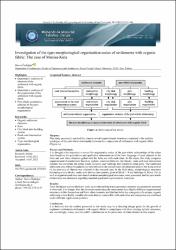| dc.contributor.author | Özdoğan, Havva | |
| dc.date.accessioned | 2023-08-17T11:02:12Z | |
| dc.date.available | 2023-08-17T11:02:12Z | |
| dc.date.issued | 2023 | en_US |
| dc.identifier.citation | Özdoğan, H. (2023). Investigation of the typo-morphological organization codes of settlements with organic fabric: The case of Manisa-Kula. Journal of the Faculty of Engineering and Architecture of Gazi University, 38(3), 1533-1546. https://doi.org/10.17341/gazimmfd.1076163 | en_US |
| dc.identifier.issn | 1300-1884 | |
| dc.identifier.issn | 1304-4915 | |
| dc.identifier.uri | https://doi.org/10.17341/gazimmfd.1076163 | |
| dc.identifier.uri | https://hdl.handle.net/11436/8046 | |
| dc.description.abstract | Purpose: This study proposed a method that aims to reveal organizational structures connected to the stylistic typologies of the part-whole relationship between the components of settlements with organic fabric (Figure A).Theory and Methods: It is thought to be important to reveal the organization codes of the part-whole relationships of the urban form based on the quantitative and qualitative determination of the form language of each element in the form and how these elements gather with the form and with each other. In this sense, this study compares organizational characteristics based on stylistic structures between city blocks, roads and road intersection systems that constitute the urban whole and plots and buildings that constitute urban parts. The traditional settlement area whose boundaries are determined in the conservation development plan of the Kula district of the province of Manisa was selected as the research area. In the field study, morphological structures belonging to city blocks, roads, road intersection systems, plots in Block 114 and buildings in Block 114, as well as organizational structures based on these morphological structures, were presented, and the part-whole relationship was discussed regarding morphological and organizational structures. Results: From the higher scale to the lower scale, an evolution from a non-geometric structure to a geometric structure is observed. It is thought that the elements constituting the settlements have highly different organizational structures within themselves and from other elements, and this has led to the emergence of a unique, organic settlement where highly variable elements that are compatible with each other and unrepeated are combined under different organization patterns.Conclusion: It is believed that the method presented in this study may be a directing design guide for the growth of unplanned settlements/settlements with organic fabric in compliance with their existing stylistic structures, and accordingly, it may have favorable contributions to the protection of urban identity in this respect. | en_US |
| dc.language.iso | eng | en_US |
| dc.publisher | Gazi Üniversitesi | en_US |
| dc.rights | info:eu-repo/semantics/openAccess | en_US |
| dc.subject | Organic settlement elements | en_US |
| dc.subject | Kula | en_US |
| dc.subject | City block-plot-building system | en_US |
| dc.subject | Road-road intersection system | en_US |
| dc.subject | Typo-morphological organization | en_US |
| dc.title | Investigation of the typo-morphological organization codes of settlements with organic fabric: The case of Manisa-Kula | en_US |
| dc.type | article | en_US |
| dc.contributor.department | RTEÜ, Mühendislik ve Mimarlık Fakültesi, Mimarlık Bölümü | en_US |
| dc.contributor.institutionauthor | Özdoğan, Havva | |
| dc.identifier.doi | 10.17341/gazimmfd.1076163 | en_US |
| dc.identifier.volume | 38 | en_US |
| dc.identifier.issue | 3 | en_US |
| dc.identifier.startpage | 1533 | en_US |
| dc.identifier.endpage | 1546 | en_US |
| dc.relation.journal | Journal of the Faculty of Engineering and Architecture of Gazi University | en_US |
| dc.relation.publicationcategory | Makale - Uluslararası Hakemli Dergi - Kurum Öğretim Elemanı | en_US |


















